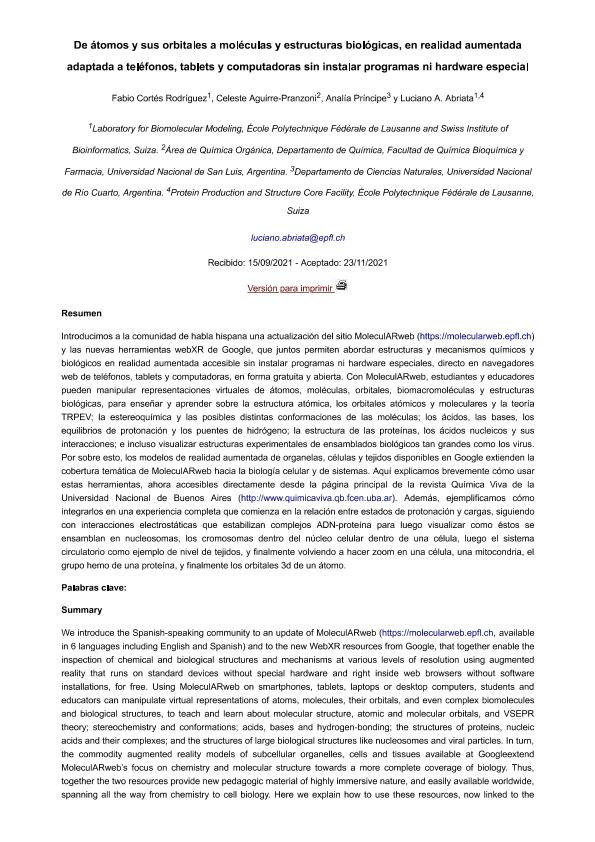Artículo
Introducimos a la comunidad de habla hispana una actualización del sitio MoleculARweb (https://molecularweb.epfl.ch) y las nuevas herramientas webXR de Google, que juntos permiten abordar estructuras y mecanismos químicos y biológicos mediante realidad aumentada accesible sin instalar programas ni hardware especiales, directo en navegadores web de teléfonos, tablets y computadoras, en forma gratuita y abierta. Con MoleculARweb, estudiantes y educadores pueden manipular representaciones virtuales de átomos, moléculas, orbitales, biomacromoléculas y estructuras biológicas, para enseñar y aprender sobre la estructura atómica, los orbitales atómicos y moleculares y la teoría TRPEV; la esteroquímica y las posibles distintas conformaciones de las moléculas; los ácidos, las bases, los equilibrios de protonación y los puentes de hidrógeno; la estructura de las proteínas, los ácidos nucleicos y sus interacciones; e incluso visualizar estructuras experimentales de ensamblados biológicos tan grandes como los virus. Por sobre esto, los modelos de realidad aumentada de organelas, células y tejidos disponibles en Google extienden la cobertura temática de MoleculARweb hacia la biología celular y de sistemas. Aquí explicamos brevemente cómo usar estas herramientas, ahora accesibles directamente desde la página principal de la revista Química Viva de la Universidad Nacional de Buenos Aires (http://www.quimicaviva.qb.fcen.uba.ar). Además, ejemplificamos cómo integrarlos en una experiencia completa que comienza en la relación entre estados de protonación y cargas, siguiendo con interacciones electrostáticas que estabilizan complejos ADN-proteina para luego visualizar como éstos se ensamblan en nucleosomas, los cromosomas dentro del núcleo celular dentro de una célula, luego el sistema circulatorio como ejemplo de nivel de tejidos, y finalmente volviendo a hacer zoom en una célula, una mitocondria, el grupo hemo de una proteína, y finalmente los orbitales 3d de un átomo. We introduce the Spanish-speaking community to an update of MoleculARweb (https://molecularweb.epfl.ch, available in 6 languages including English and Spanish) and to the new WebXR resources from Google, that together enable the inspection of chemical and biological structures and mechanisms at various levels of resolution using augmented reality that runs on standard devices without special hardware and right inside web browsers without software installations, for free. Using MoleculARweb on smartphones, tablets, laptops or desktop computers, students and educators can manipulate virtual representations of atoms, molecules, their orbitals, and even complex biomolecules and biological structures, to teach and learn about molecular structure, atomic and molecular orbitals, and VSEPR theory; stereochemistry and conformations; acids, bases and hydrogen-bonding; the structures of proteins, nucleic acids and their complexes; and the structures of large biological structures like nucleosomes and viral particles. In turn, the commodity augmented reality models of subcellular organelles, cells and tissues available at Googleextend MoleculARweb’s focus on chemistry and molecular structure towards a more complete coverage of biology. Thus, together the two resources provide new pedagogic material of highly immersive nature, and easily available worldwide, spanning all the way from chemistry to cell biology. Here we explain how to use these resources, now linked to the home page of the Química Viva journal at the National University of Buenos Aires (http://www.quimicaviva.qb.fcen.uba.ar), and exemplify their integration into a full experience that spans from molecular protonation states and the resulting charges to protein-DNA interaction, their packing into nucleosomes, the chromosomes inside cells, and the human circulatory system, then zooming back out to cells, the mitochondrion, a heme group, and the 3d orbitals.
De átomos y sus orbitales a moléculas y estructuras biológicas, en realidad aumentada adaptada a teléfonos, tablets y computadoras sin instalar programas ni hardware especial
Fecha de publicación:
11/2021
Editorial:
Universidad de Buenos Aires. Facultad de Ciencias Exactas y Naturales. Departamento de Química Biológica
Revista:
Química Viva
ISSN:
1666-7948
Idioma:
Español
Tipo de recurso:
Artículo publicado
Clasificación temática:
Resumen
Palabras clave:
REALIDAD AUMENTADA
,
FORMULACION
,
BIOMOLECULAS
,
TIC
Archivos asociados
Licencia
Identificadores
Colecciones
Articulos(INTEQUI)
Articulos de INST. DE INVEST. EN TECNOLOGIA QUIMICA
Articulos de INST. DE INVEST. EN TECNOLOGIA QUIMICA
Citación
Cortez Rodriguez, Fabio; Aguirre Pranzoni, Celeste Beatriz; Principe, Analia; Abriata, Luciano; De átomos y sus orbitales a moléculas y estructuras biológicas, en realidad aumentada adaptada a teléfonos, tablets y computadoras sin instalar programas ni hardware especial; Universidad de Buenos Aires. Facultad de Ciencias Exactas y Naturales. Departamento de Química Biológica; Química Viva; 3; 11-2021; 1-13
Compartir




